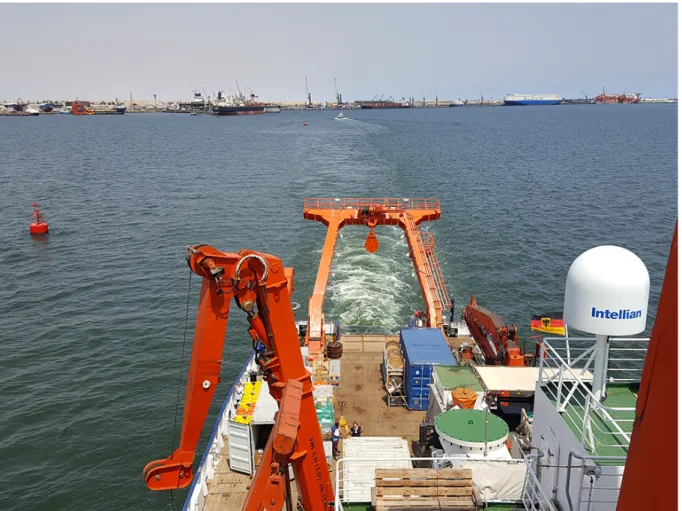Prof. Dr. Peter Brandt Meteor cruise 158
1
stWeekly Report M158, Walvis Bay-Recife
Sept. 19-Sept. 2 2019
With the departure of the German research vessel METEOR from the port of Walvis Bay, Namibia on Sep. 19 a series of three expeditions under the direction of the GEOMAR Helmholtz Centre for Ocean Research Kiel, which will end in Mindelo, Cape Verde at the end of the year began. All three cruises are dedicated to the study of physical, biogeochemical and biological processes in the tropical Atlantic, which play a crucial role in climate and weather patterns on the surrounding
continents as well as in global carbon and nitrogen cycles or marine ecosystems.
Unfortunately, the METEOR cruise M158 started very unpleasantly. Three scientific crew members could not join the cruise due to missing visas. Unfortunately, this also means that some measurements, like e.g. various biogeochemical underway measurements, cannot be carried out as planned.
With the departure of RV METEOR on Sep. 19 at 13:00, the transit to our first
research area off the coast of Angola began. Since 2013, seagoing measurements have been carried out in various research projects. These include in particular the projects SACUS and BANINO, which are part of the SPACES program of the BMBF.
These projects focus in particular on the emergence and development of Benguela Niños. Similar to the El Niño in the Pacific, these large-scale climatic events are associated with an increased surface temperature on the eastern sides of the tropical oceans, especially off the coast of Angola and Namibia. They have far-reaching impacts on marine ecosystems, fish and fishery as well as on the precipitation in southern Africa.
A recently accepted EU project TRIATLAS is investigating the state and development of marine ecosystems in the tropical and South Atlantic. As part of this project, we will also work together with our European, African, and South American colleagues on the role of phytoplankton, zooplankton and particle distribution for carbon export to the deep sea or nitrogen fixation at the surface.
Prof. Dr. Peter Brandt Meteor cruise 158
Fig. 1: Departure of RV METEOR from the port of Walvis Bay, Namibia (Photo: Peter Brandt) .
The first days of our cruise were filled with the installation of the different measuring systems. In particular, our standard instrument, the CTD (temperature, salinity, pressure probe) , has been strongly enhanced by additional sensors and instruments.
To allow a truly interdisciplinary study, sensors for measuring oxygen, fluorescence (chlorophyll) , turbidity, colored dissolved organic matter, radiation, nutrients, as well as instruments for acoustic measurement of fish and zooplankton and for optical measurement of zooplankton and particles in various size classes have been installed.
Water samples are used to study the distribution of different dissolved or particulate substances or to calibrate the instruments of the CTD. During our transit to the research area off Angola, we were able to carry out first measurements with the CTD system as well as with a microstructure probe. Sunday evening we started with the measurement of our eastern boundary current section at about 11°S.
The first familiarization phase has been completed and all have settled in well within the great working atmosphere onboard RV METEOR. Many whales, dolphins, seals, turtles could also be admired off the coast of Namibia and Angola and certainly contribute to a very good mood.
Greetings from the tropics in the name of the cruise participants of M158, Peter Brandt
GEOMAR Helmholtz Centre for Ocean Research Kiel
